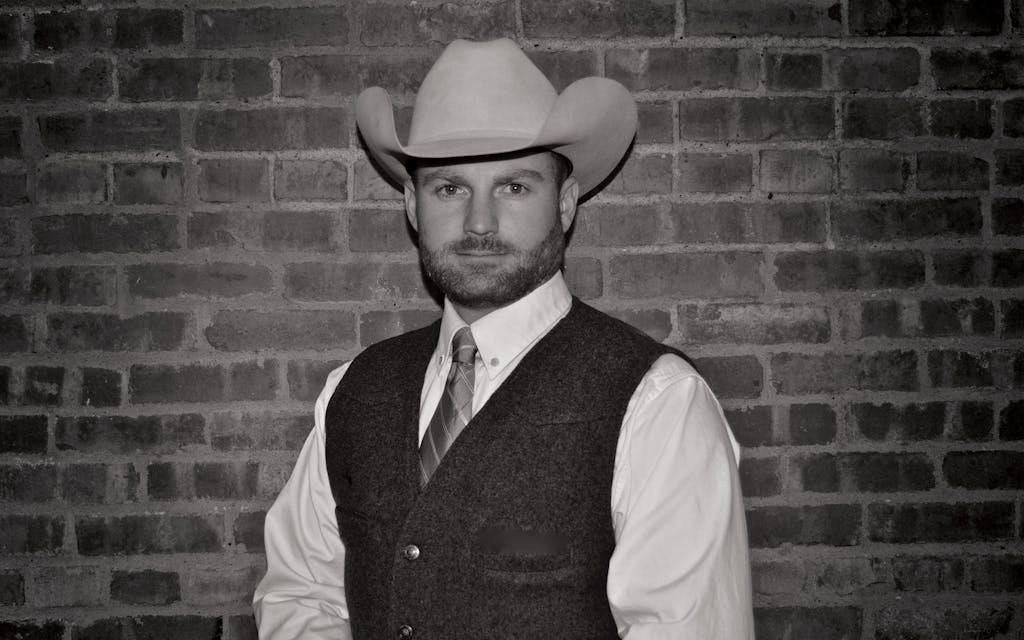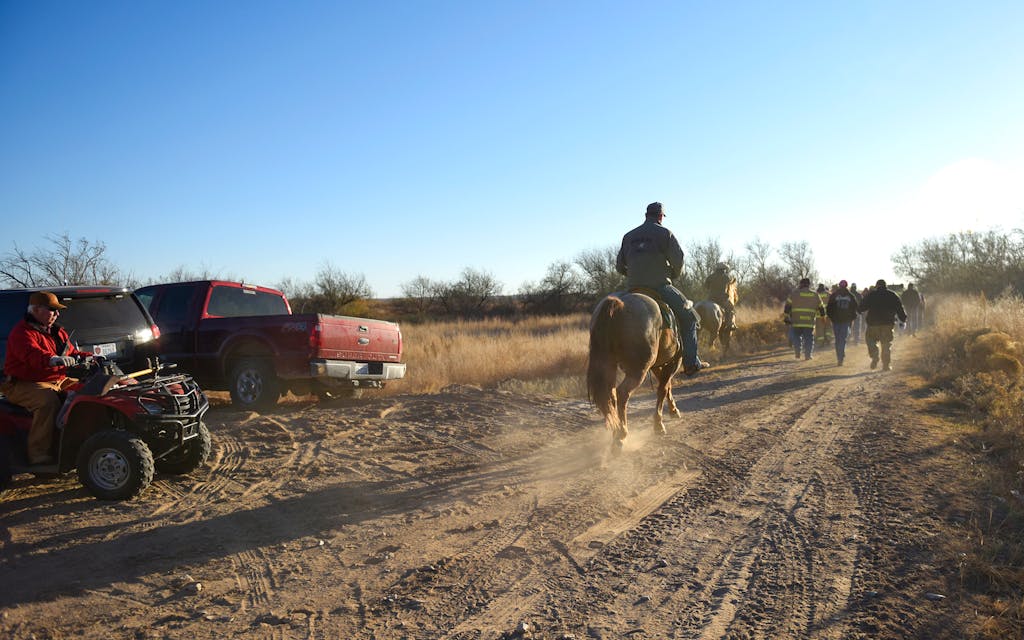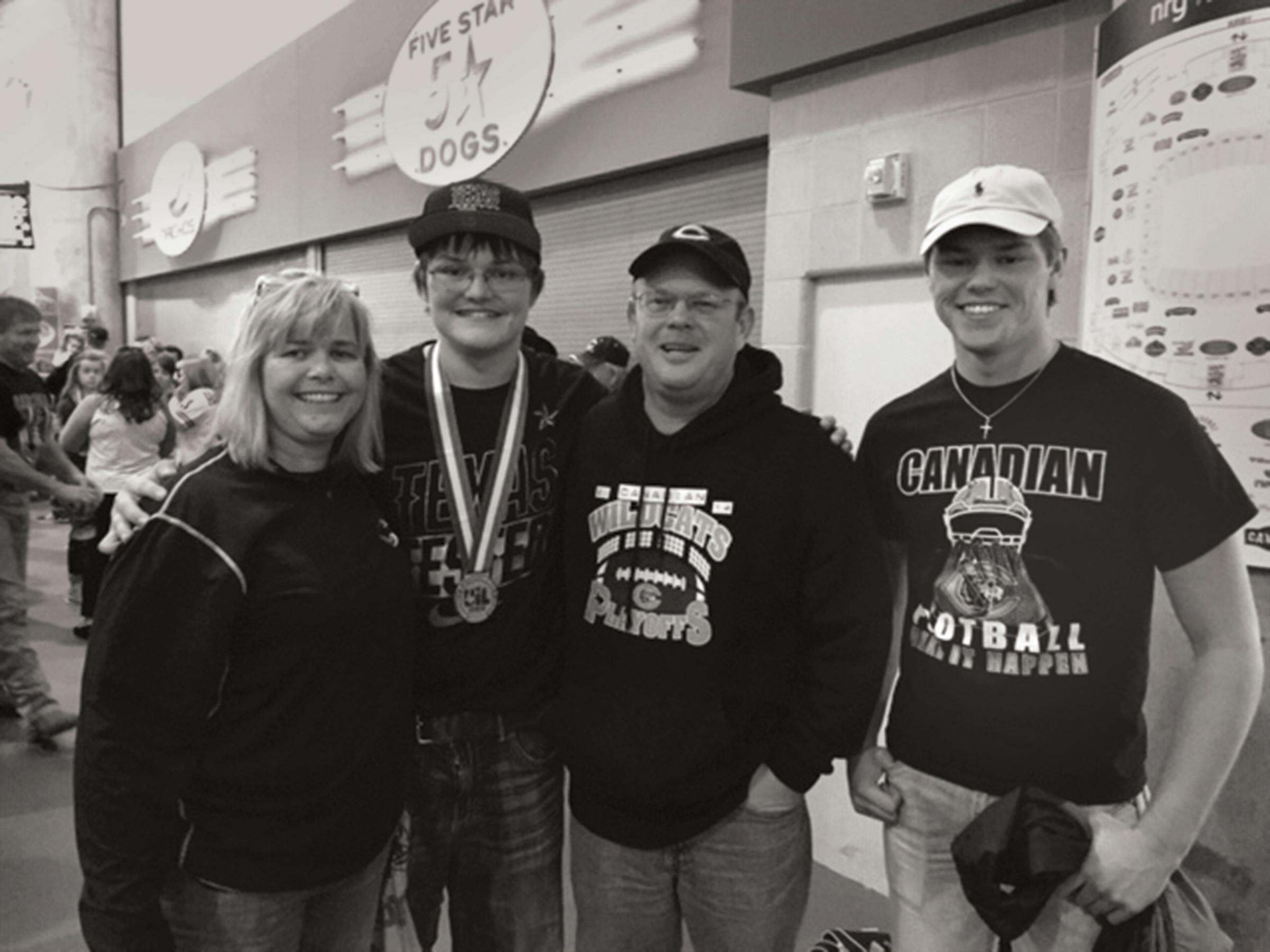Subscribe
At the stroke of midnight on Thanksgiving eve, 2016, Penny Meek checked her phone. Her son Tom Brown had gone cruising with a few friends that evening, and his curfew was midnight. According to Penny, Tom was rarely late. If he was going to miss curfew by a few minutes, he always called or texted to let her know. But that night she hadn’t heard from him.
Penny said she called and texted Tom. Tom’s older brother, Tucker, who was in the living room watching a movie with his friend Taylor Russell, did the same. But Tom didn’t answer.
At around 12:30, Penny woke her husband Chris and told him she was going to look for Tom. She grabbed her keys and climbed in her Chevy Suburban. Tucker and Taylor piled into Tucker’s Toyota 4Runner. Penny drove around town, while Tucker scoured the surrounding highways and farm-to-market roads. He said he feared Tom had been in an accident—“and you know, if that’s what happened, we could get him some help and save his life,” Tucker told me.
After an hour or so, Tucker said, he dropped Taylor off at his house, and then he continued searching for Tom for another hour. Meanwhile, Penny returned home and called Kaleb King, who had been with Tom earlier that evening, to ask if he had any idea where Tom might be.
Kaleb was taken aback—he knew his friend to always make it home by curfew—so he called Michael Caseltine and Christian Webb, who had also gone cruising with Tom that night. Neither had any idea what might’ve happened. “My first thought was that he had just gotten a flat tire,” Christian later told me. “I mean, nothing ever happens in Canadian—nothing terrible. So, I mean, I was concerned, but I didn’t have a huge amount of concern.”
Kaleb, Michael, and Christian each got in their own cars to search for Tom. Kaleb was accompanied by his mother. They drove everywhere: downtown, the football stadium, the rodeo arena, even out to Lake Marvin, the reservoir east of Canadian that’s surrounded by campsites and picnic areas.

At roughly 2:30 a.m. on Thanksgiving morning, Penny called the sheriff’s department in Canadian to report Tom as missing. (There is no local police department.) The dispatcher relayed the news to a deputy on duty named Pyne Gregory. According to the report later filed by Gregory, he first drove around town looking for Tom’s Durango. Then, around 4 a.m., he pulled up to the Meeks’ home. Penny, Chris, and Tucker met the deputy on the front porch. Maybe, they suggested, Tom had gone to see Saige Pennington, the girl he had recently stopped dating. They’d heard she was home for Thanksgiving weekend. Tucker told Gregory he’d ride along and show him where Saige lived, about eight miles outside of town. But when they arrived, Tom’s Durango wasn’t there.
By 7:30 a.m., Penny and Chris were on their way to see Nathan Lewis, the sheriff of Hemphill County, of which Canadian is the county seat. Lewis is a handsome 32-year-old with short red hair and a neatly trimmed beard. (Residents say he looks exactly like the NASCAR driver Dale Earnhardt Jr.) A native of Canadian—his father used to be mayor—Lewis began working for small-town Panhandle police departments when he was in his early twenties. In September 2016 he took over as sheriff of Hemphill County after campaigning on a war on drugs platform, telling voters that he and his deputies would stop at nothing to bring down the drug dealers scattered around the county, which is nine hundred square miles in size.
Lewis quickly proved to be good at drug busts: he started making arrests soon after he was sworn into office that September. But he had never conducted a missing person’s case. And suddenly, here he was, talking to Penny about where her son might possibly have gone.
Lewis and Penny knew one another. They and their families both attended First United Methodist Church. But they weren’t exactly friends—and it all had to do with Tom. Just a year earlier, in 2015, Lewis was working as a sheriff’s deputy in a neighboring county. Late one night, driving back to his home in Canadian, he noticed a handful of teenagers, including Tom, hanging around the Palace movie theater. Lewis suspected they were up to no good. He ordered Tom into his truck. “I said, ‘Tom, what the hell are y’all doing?’ ” Lewis told me. “ ‘You guys need to get y’all’s butts home.’ ”
Tom told Penny a different story. He said that he and his friends were only looking for a friend whose father ran the theater, and that Lewis had accosted him. Penny was so upset that she filed a complaint against Lewis with the sheriff’s department. Although it went nowhere—Lewis insisted that he had not mistreated Tom—Penny began telling her friends that Lewis should never become sheriff of Hemphill County. “I felt like if he was elected sheriff, that’s what he was going do to our kids in the community all the time,” she said. “Like he was just going to mess with them.”
When I spoke to Lewis, he said he didn’t begrudge Penny over the movie theater incident. He said that when she and Chris arrived at his office, worried about Tom, he treated them with respect. But, he admitted, he was initially skeptical that Tom really was missing. “To be honest with you, I figured that we had a high school kid who went out and partied and didn’t come home on time,” Lewis said.
Not long after their meeting, however, Lewis got a phone call. Tom’s Durango had been found.

Earlier that morning, Christian Webb and her father, Trey, a well-to-do Canadian resident who owns a helicopter sales and service company, had decided to search for Tom in one of the company’s four-seater helicopters. Trey was an experienced pilot, and he hovered low to the ground, crisscrossing Canadian and the surrounding area. He and Christian spotted Tom’s red Durango parked under a small grove of trees across a dirt road from the water treatment plant just north of town. It was a strange place to find the vehicle, Christian said. She had no idea the dirt road even existed. “And I was almost sure that Tom didn’t know about it. We never drove up to that point at all.”
After getting the call, Lewis raced to the scene. He and a deputy approached the Durango. “We walked around the car several times, looking around,” he said. “There was nobody in the car. Then we started circling around, you know, kind of looking in the area to see if we could see anything, find anything.”
Because it hadn’t rained for several days, the ground was packed and not conducive to footprints. Still, Lewis said, he and the deputy did spot one light shoe print outside the driver’s door. They also noticed what looked to be a urine mark near the same door. Scattered inside the Durango, which was unlocked, were cans of smokeless tobacco, two pairs of football cleats, towels, jumper cables, a pillow, and a clown costume (which Tom had worn for a school drama production, Penny later told me). There was no sign of his wallet, his keys, his cellphone, or his mother’s debit card.
Lewis, however, did spy Michael Caseltine’s debit card, which had fallen between the front seats. And there was a thin streak of blood on the inside of the front driver’s door by the handle. “It looked like it was probably a knuckle cut or something, or a finger cut or paper cut,” he said. “It was very dry.”
There was one other thing Lewis and his deputy discovered: a .25-caliber shell casing on the floorboard. Lewis said he was confounded, because as far as he could tell, “there was nothing in the car that said that there was a gunshot that went off in that car. There was no splatter. There was no gunpowder residue in the car. There was nothing.”

Within minutes, the news about Tom’s abandoned Durango was racing through town like a prairie fire. Some residents postponed their Thanksgiving meals, drove to the water treatment plant, and started searching for Tom on foot, horseback, and four-wheelers. Trey and Christian Webb continued scanning for Tom from their helicopter, and the Webbs’ son, Emmett, joined the search in a second helicopter. Game wardens arrived with a tracking dog. But no one spotted Tom, and the dog couldn’t find a scent to follow.
As the day wore on, friends and neighbors dropped by Penny’s house with leftover turkey and pumpkin pie and words of encouragement. Tom and Tucker’s father, Kelly Brown, a bank examiner, drove in from Perryton, 46 miles to the northwest. (“I was shaking so bad I couldn’t stand it,” he told me.) At some point that afternoon, Sheriff Lewis talked to Penny. He asked if anyone in her family owned a .25-caliber pistol. No, she said. “And then, he just said he was returning the car,” Penny told me. “I said, ‘Why are you bringing the car back?’ And he said, ‘Well, we’re done with it; we don’t need it anymore.’ And I said, ‘You’re telling me you processed the car? You’ve gotten fingerprints or whatever from the car?’ ‘Well, we don’t need it anymore,’ he told me. I said, ‘Okay.’ ”
When the Durango arrived, Tucker did his own examination of the vehicle and found nothing “out of the ordinary.” But the next morning, Lewis ordered that the Durango be towed back to the sheriff’s department. He told me he had spent a sleepless night thinking he should inspect the Durango one more time to make sure no evidence was overlooked. “We did everything again,” he said. “We re-wiped the blood spot. We went and we put more ink on that car, fingerprint dust, than you can imagine to make sure we didn’t miss anything.”
Actually, however, something was missing—which no one noticed until the superintendent of Canadian public schools dropped by Penny’s house to check on her. The superintendent asked if anyone had seen Tom’s school computer. If Tom had been using it to get online, he said, perhaps it could be traced.
Penny said that Tom stowed his computer and his schoolbooks in his backpack, which he almost always left in the Durango unless he needed to bring it inside the house to do homework. She said she hadn’t seen it. Tucker mentioned that he hadn’t seen the backpack either. Perhaps Tom had taken it with him after leaving the Durango.
Attempts to trace Tom’s laptop were unsuccessful, but the absence of his backpack was puzzling. Why would Tom park the Durango by the water treatment plant—a place that was supposedly foreign to him—and walk away, carrying his wallet, his keys, his cellphone, and his backpack containing his books and laptop? And where in the world would he be going?
Or had something else entirely taken place in those early hours of Thanksgiving morning? Something that no one could yet imagine?


Over the next few days, Sheriff Lewis intensified the search for Tom. He called in veteran bloodhounds from the state prison in Amarillo. The dogs were taken by their handlers to the dirt road where the Durango had been found and were given pieces of Tom’s clothes to sniff. They picked up a scent, which they began to follow, east to northeast, for three quarters of a mile. But the scent disappeared at the edge of a marshy slough, and the dogs turned back.
Lewis also arranged for a grid search: dozens of people, several of them volunteer firefighters, walked side by side, combing a two-mile area surrounding the water treatment plant. They turned up nothing. Later, Lewis brought in a mounted search-and-rescue team from nearby Randall County. They started at the Canadian River and rode their horses east along the river bottoms, to Lake Marvin. They couldn’t find any sign of Tom either.
The truth was that Tom’s friends hadn’t anticipated that much would come from Lewis’s search-and-rescue efforts. They couldn’t imagine Tom getting out of his Durango in the daytime—let alone in darkness—to trek through the woods. “That seems highly impossible to me,” said Christian. “Tom wasn’t an outdoors man at all. He liked having his phone and his video games, and he never did outdoorsy things. And I mean, it was freezing cold that night and he wasn’t wearing many clothes. The clothes he was wearing were really thin.”
Lewis and his deputies had better luck studying the grainy, black and white video footage from security cameras posted around town. On the night Tom disappeared, a camera in front of a convenience store on Second Street, in the heart of town, had captured Tom’s Durango just after midnight, heading up a street—possibly toward his home—but then coming back down the same street a few minutes later. Around 5:30 a.m., a camera caught the Durango ambling through downtown, turning in the direction of Tom’s home, and again backtracking. Then, at 5:56 a.m., the Durango was picked up by a camera positioned atop a city-owned building near the water treatment plant. It showed the vehicle moving slowly along the dirt road, passing through the already opened gate, and parking. The headlights went off. There was total darkness. No one could be seen getting in or out.
What had seemed like a potential lead only raised more questions. Why would Tom be driving around Canadian in those early morning hours, dodging his family and friends and the sheriff’s deputy who were out looking for him? Why would he drive toward his home? Of all the places he could have chosen to abandon the Durango, why would he pick the water treatment plant?
Or what if he hadn’t walked into the woods at all? For that matter: What if someone else was driving the car?

The afternoon of November 26, Penny and Chris were called into the sheriff’s department to be interviewed again. This time, the questioning was handled by Lewis’s chief deputy, Brent Clapp, a former Panhandle ranch hand with an Old West handlebar mustache who had been in law enforcement for more than a decade. A Department of Public Safety state trooper Clapp knew also sat in on the conversation. Chris was interviewed first. He said Penny was Tom’s main caregiver and that he was basically an “observer” who mostly talked sports with Tom. He said he had no idea why the boy had disappeared.
Penny went next. She started off by describing what Tom’s friends often said about him: that he was “nice to everybody” and had “a soft heart, especially for the underdog.” She said she hadn’t noticed any recent changes in behavior. “I mean, nothing. And I have been in contact with several of his teachers, and his teachers have said he was doing great in school. Even the teachers who don’t have him in class this year that maybe had him in past years were like, ‘I’ve seen him in the hall and he’s laughing and smiling.’ ”
The officers then moved on to Tom’s disappearance, asking Penny what first came to mind when she heard the Durango had been found at the water treatment plant. Penny didn’t hesitate. “I thought he committed suicide,” she replied.
There was a brief silence. “Tell me why,” the DPS trooper said.
“Because it runs in my family,” Penny explained. “And I just figured maybe at that point he was distraught about breaking up with his girlfriend.”
There was another silence. One of the officers asked Penny how Tom might have killed himself. “I figured it would have been like the choking game,” she said.
The choking game, also known as the “blackout game” or the “good kid’s high,” has garnered occasional headlines over the years. It’s most commonly attempted by teenage boys: someone intentionally strangles himself or someone else, and the lack of oxygen leads to a feeling of euphoria and brief loss of consciousness. But it has also resulted in accidental deaths.
Penny quickly pivoted, telling the officers that she didn’t actually know much about the choking game. But the thought randomly occurred to her, she said, because Tom “is not a gun person. I had already checked for the guns in the house. All of ours were accounted for. I’d already checked meds. Everything was accounted for.”
It turned out that Penny’s father, suffering from depression, had shot himself to death in 1998—eighteen years earlier—so Penny’s sensitivity to suicide was understandable. But why, I later asked Penny, was it the first thought that came to mind when Tom went missing?

“Well,” she explained, “I was thinking, he’s a senior. His boat is loaded as far as academics. He doesn’t really know where he wants to go to college. And he’s broken up with his girlfriend. I mean, the kid had a lot on his plate. And so, was suicide completely out of the realm of possibility? No, not really. I don’t think it’s out of the realm of any of our high school kids to commit suicide at all.”
But when I asked if she ever sensed Tom was depressed, she shook her head no. “His state of mind, even the day that he disappeared, he was regular Thomas. I mean, there was nothing different about him that day. So I just don’t think that he committed suicide at all.”
During her interview at the sheriff’s department, the officers asked Penny if Tom could have left Canadian with someone she didn’t know. Penny said she didn’t think so, but she did offer another theory about Tom’s disappearance. Maybe Tom had gone off to pursue one of his dreams. “This may be a bit of a stretch,” Penny said. “And I don’t even know how he would get there. But he tells me he loves WWE wrestling. And, you know, he has asked me before, ‘Well, can I be a wrestler?’ And I’m like, ‘You do whatever you want when you get out of college, you know?’ And he’s like, ‘Will you pay for it?’ And I’m like, ‘I’m paying for college and that’s it.’ ”
As the interview came to a close, Penny sounded hopeful—at least for a moment. “Honestly, my gut tells me he hasn’t left Hemphill County,” she said. “I would think at this point he’s hiding somewhere. We just don’t know where. I think he’s here somewhere, and I don’t know if he intends to come out in the next day or two. I don’t know.”
After watching a video of the interview with Penny, Lewis told his deputies that he was struck by Penny’s mention of suicide. But that wasn’t the most jarring revelation that day.
Another of Lewis’s deputies, Jerri Lynn Ortega, stopped into Lewis’s office to debrief him after an interview she’d conducted with Tom’s ex-girlfriend Saige Pennington. Saige had told her something unusual, Ortega said. Saige said that Tom liked to occasionally wear men’s diapers. He had confided in her earlier that spring and was clearly embarrassed, she explained. It wasn’t clear who else—if anyone—knew.
Saige’s revelation led Lewis to suspect that Penny was withholding important information about Tom, so he arranged to meet with her again a few days later. This time, she was accompanied by two friends. When they gathered in Lewis’s office, he began with a routine update on the investigation. Then, recalled Penny, he confronted her about knowing that Tom wore men’s diapers. Penny was incensed. “I said, ‘I don’t even know what you’re talking about. I don’t know where you got that information. What are you talking about?’”
Penny went home and told her friends and family that she’d lost trust in Lewis. He was too inexperienced, she said. He didn’t even put yellow crime-scene tape around the Durango when he inspected it. And now he was trying to trash Tom’s reputation. Penny decided she needed to hire a proven private investigator. A friend sent her an article about Philip Klein, the owner of Klein Investigations and Consulting, which is headquartered in the town of Nederland, ninety miles east of Houston.
Klein is a celebrity of sorts in the missing persons world. He claims to have investigated more than 1,800 missing persons cases over the last 25 years, with an 80 percent success rate. Penny was confident he could find Tom.
She picked up her phone.
Read Chapter 3: “Evil Has Come to Canadian, Texas”
Chapter 1: A Pretty Little Place
This article originally appeared in the October 2020 issue of Texas Monthly with the headline “Tom Brown’s Body.” Subscribe today.









